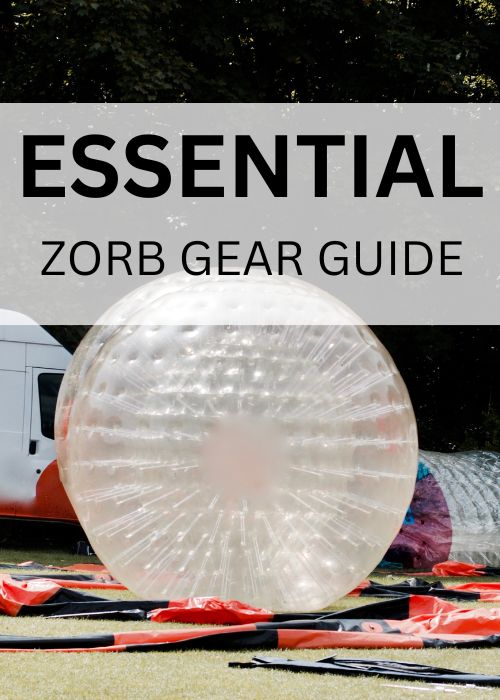
Essential Zorbing Gear: Everything You Need for the Ultimate Adventure
Zorbing is an adventure sport that combines thrill, fun, and a dash of the unexpected.
Whether you’re a first-timer or a seasoned zorbing enthusiast, having the right gear can make all the difference in your experience.
From the essential zorbing ball to the must-have accessories, this guide will walk you through everything you need to gear up for the ultimate zorbing ride.
1. The Zorb Ball: Your Primary Gear
At the heart of zorbing is the zorb ball itself. This giant, inflatable sphere is what makes the sport possible. But not all Zorb balls are created equal.
Here’s what to look for:
- Material: Most Zorb balls are made from thermoplastic polyurethane (TPU) or polyvinyl chloride (PVC). TPU is generally more durable and eco-friendly, while PVC is more affordable. Choose the material based on your needs and how frequently you plan to zorb.
- Size: Zorb balls come in various sizes, typically ranging from 2.5 to 3.5 meters in diameter. The larger the ball, the more space you have inside, which can enhance the experience. However, larger balls are also heavier, so consider your own strength and the terrain you’ll be zorbing on.
- Double-Layered Balls: For added safety, opt for a double-layered zorb ball, which has an inner and outer layer with air in between. This design provides extra cushioning and absorbs more impact, making the ride smoother and safer.
- Harness vs. Non-Harness Balls: Some zorb balls come with an internal harness to secure you in place, while others allow you to roll freely inside. Harnessed balls offer more control and stability, which is ideal for those new to zorbing or for specific types of zorbing like downhill runs. Non-harness balls provide a wilder, more chaotic experience as you bounce and roll freely.
2. Appropriate Clothing: Dress for Comfort and Safety
While zorbing, comfort and flexibility are key. Here’s what to wear:
- Lightweight, Breathable Clothing: Wear moisture-wicking, breathable clothes to keep cool inside the ball. Avoid heavy fabrics that can overheat you or restrict movement.
- Comfortable Footwear: Depending on the type of zorbing, you may or may not need shoes. If you’re zorbing on a smooth surface or water, barefoot or water shoes are fine. For downhill zorbing, opt for lightweight sneakers that provide grip and protect your feet.
- Avoid Loose Items: Remove any loose items like jewelry, hats, or sunglasses before zorbing. These can become hazards inside the Zorb ball.
3. Safety Gear: Essential for Peace of Mind
Even though zorbing is relatively safe, it’s important to take precautions:
- Helmet: While not always required, wearing a helmet is a good idea, especially for high-speed zorbing or more challenging terrains. A lightweight, well-ventilated helmet can help protect your head from impacts.
- Knee and Elbow Pads: For added protection, consider wearing knee and elbow pads, especially if you’re new to zorbing or plan to tackle more aggressive runs. These pads can cushion falls and protect against scrapes.
- Safety Harness: If you’re using a non-harnessed Zorb ball but still want some security, a safety harness can be a good addition. This can help prevent you from being tossed around too much inside the ball.
4. Additional Accessories: Enhance Your Zorbing Experience
To make your zorbing adventure even more enjoyable, consider these additional accessories:
- GoPro or Action Camera: Capture your zorbing experience from inside the ball with a mounted GoPro or similar action camera. Make sure it’s securely fastened to avoid any damage or loss during the ride.
- Waterproof Pouch: If you plan to bring your phone or other small items along, use a waterproof pouch to keep them dry and secure inside the Zorb ball.
- Hydration Pack: Zorbing can be a workout, so staying hydrated is important. A small hydration pack or bottle can be brought inside the Zorb ball for easy access.
5. Choosing the Right Terrain: Zorbing Locations Matter
The type of terrain you choose for zorbing can significantly impact your gear needs:
- Grass Hills: Ideal for beginners, grassy hills are soft and forgiving. Ensure your zorb ball is suitable for uneven terrain.
- Water Zorbing: For zorbing on water, you’ll need a ball designed specifically for water use, often referred to as a water walking ball. These are typically single-layered and waterproof.
- Obstacle Courses: If you’re up for a challenge, some zorbing parks offer obstacle courses. Here, you’ll want a durable, double-layered ball and may need additional protective gear like knee pads or helmets.
6. Maintenance and Care: Keep Your Gear in Top Condition
To ensure your zorb ball and accessories last, proper maintenance is key:
- Regular Inspections: Check your zorb ball for any signs of wear, punctures, or leaks before each use. Small repairs can often be made with a patch kit.
- Proper Storage: Store your zorb ball in a cool, dry place away from direct sunlight to prevent material degradation. Deflate the ball and store it flat to avoid creases or damage.
- Cleaning: After each use, clean your zorb ball with mild soap and water, especially if you’ve been zorbing in mud or water. Ensure it’s fully dry before storing it to prevent mold or mildew.
Conclusion
Zorbing is an exhilarating adventure that promises a unique experience each time you step inside the ball.
By equipping yourself with the right gear—starting with a quality Zorb ball and the appropriate safety equipment—you’ll be set for an unforgettable ride.
Remember, preparation is key to maximizing the fun and minimizing risks.
Whether you’re a first-time zorber or a seasoned pro, this guide ensures you’re fully prepared for the ultimate zorbing adventure.
So gear up, roll out, and get ready to zorb like never before!
More Zorbing:
Zorbing vs other adventurous sports.
Essential Zorbing Guide.